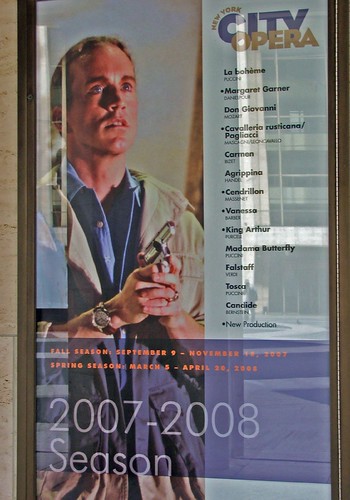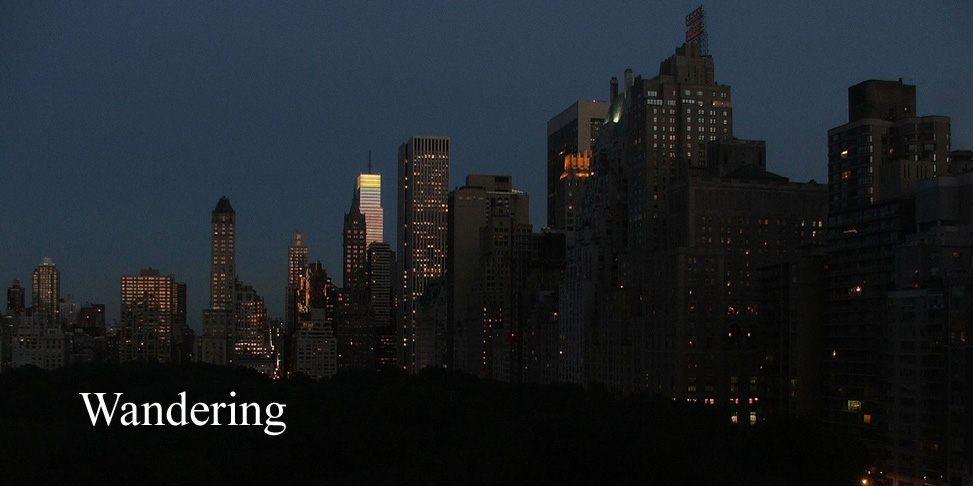
David Walker as Ottone with automatic weapon and reflections.
I had almost given up on New York City Opera. The performances I had seen there were interesting but I always found something to complain to myself about, rightly or wrongly.
On 2 November, I saw Handel’s Agrippina which is a co production with Glimmerglass Opera. As well as my City Opera phobia I had concerns that Agrippina was an early Handel opera, first performed in Venice in about 1710. Early Handel is fine by me: I should look into it further, but it seems that at that point in his career Handel was less bound by the traditions of opera seria or maybe those traditions hadn’t fully developed. The music is fresh and lively and although Handel later recycled some of it, nothing was familiar to me. The orchestra included recorders, lute and baroque guitar and theorbos but was otherwise made up of modern instruments. There must have been some amplification of these instruments; and I understand that amplification is common in the State Theatre in any event to combat the bad acoustics, but I didn’t notice it. Last year I heard Semele in the State theatre and from where I was then seated in the back of the main auditorium I heard some peculiar effects which made the sound jumbled at times.
There is a delightful flute solo in the second act, and when I looked down, there was the conductor, Ransom Wilson, on his podium playing it. This was a first for me. Afterwards, I thought that I had been suffering from some kind of delusion but search on the net showed that Mr. Wilson is a well established flutist as well as a conductor.
The production was lively, funny, and well sung. The opera itself takes an ironic view of the historical events it portrays and this view is developed by the production. The sets are mobile structures which are moved to form the various rooms and spaces where the action takes place. They are decorated with bits and pieces of Ancient Rome to give the correct sense of place. There are also some simple abstract shapes in strong colours which are used from time to time to provide visual contrasts.
The singers are in modern dress, and there are firearms. Both were keys to the way the production worked and were not intrusive. The dress and firearms in the Met’s production of Macbeth seemed unnecessary, as I have said. I wonder if there is a rule about this. There is always the risk that impressions like this depend more on how you are feeling at the time than any real fault in a production.
As an example, at the time of the events portrayed, Nero, Agrippina’s son is an adolescent. He is sung by mezzo soprano Jennifa Rivera who manages to include aspects of normal adolescent behaviour with strong hints of the pathological character which the historical Nero became. She is helped by the modern wardrobe which establishes that Nero has a narcissistic interest in fashionable dress, and by the firearms. Early in the first Act after doting on his mother Agrippina, he is left alone with a revolver, and plays a game of Russian roulette which ends with a maniacal laugh when he survives.
Arrippina , whose machinations would put any modern politician to shame, was given a delightfully ironic and wonderfully sung portrayal by Nelly Miricioiu. Ottone, the only character innocent of guile, was countertenor David Walker, to be heard again soon as Holofernes in Juditha Triumphans Pinchgut Opera's 2007 production.
The minor character Narciso was David Korn, described as a male soprano. I find that this description is used for a counter tenor who sings in the female soprano range; the more common range for counter tenors being equivalent to mezzo soprano or contralto.
There is an article about the male soprano or sopranist here: http://en.wikipedia.org/wiki/Male_soprano
Knowing nothing of the technicalities of the subject I can’t comment on its accuracy.





No comments:
Post a Comment